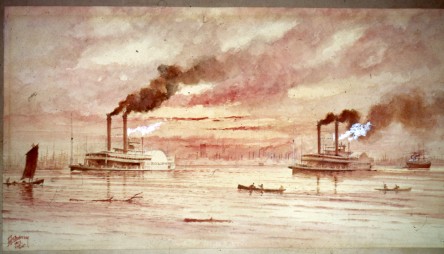For early 20th-century artist Frederick Tanqueray (“F.T.”) Anderson, it is hard to know what came first–his love of watercolors or his love of steamboats.
Anderson found inspiration through memories of boyhood travels down the Mississippi River to New Orleans. In fact, many regarded him as the leading river scenes painter of all time, according to a 1945 article in The (Memphis) Commercial Appeal.
Anderson enthusiasts may once again enjoy his works through an online exhibit hosted in partnership with the University of Arkansas at Little Rock Center for Arkansas History and Culture (CAHC) and The Arts & Science Center of Southeast Arkansas (ASC).
The virtual exhibit is part of an upcoming symposium, “As much as the water: How steamboats shaped Arkansas,” set for Nov. 5, at the Arkansas Studies Institute building in downtown Little Rock.
The event is free and open to the public.
“In spite of any harsh facts, including steamboats’ role in Native American Removal, slavery, and deforestation, his paintings bring to life an era in which these vessels changed the economy and culture of the south and the U.S.,” according to Dr. Lenore Shoults of the ASC.
Shoults is scheduled to speak as part of a panel of experts who will discuss “The Life and Times of Frederick T. Anderson: Arkansas Steamboat Artist,” during the Nov. 5 symposium in the Arkansas Studies Institute building in the River Market area of Little Rock.
Anderson failed to gain significant notoriety with the exception that President Theodore Roosevelt was presented with one of his paintings during travels to Memphis in 1907, according to Shoults.
Roosevelt greatly admired the work, and subsequently, Anderson did three additional paintings for the president, including a painting of the steamboat New Orleans, captained by Nicholas Roosevelt in 1811, one of Theodore Roosevelt’s ancestors.
Anderson’s works are part of a digital exhibit presented in conjunction with the UALR CAHC, available at: ualrexhibits.org/steamboats/virtual-exhibit/frederick-tanqueray-andersons-steamboats/.
His works have been exhibited only three times previously:
-
1915 at the residence of Mr. and Mrs. Edward Craig, Bentonville
-
1945 at the Brooks Memorial Art Gallery, now the Memphis Brooks Museum of Art
-
1983 at the Southeast Arkansas Arts and Science Center, Pine Bluff, Arkansas, now The Arts & Science Center for Southeast Arkansas (ASC).
Anderson died Nov. 14, 1926 and is buried next to his wife in Memphis’ Elmwood Cemetery.
For more details on the symposium and to see the full list of scheduled speakers, visit http://ualrexhibits.org/steamboats/events/ or contact the center at 501.320.5780.
More about the steamboat symposium
The invention of Robert Fulton’s steamboat in 1807 is one of the defining moments in American history, a development that held ramifications for many states, Arkansas included.
A current online exhibit exploring the steamboat’s influence on Arkansas culminates with a day-long educational symposium at the Arkansas Studies Institute building.
Among the featured symposium panelists are former U.S. Congressman Vic Snyder, who is serving on a panel discussing maritime policy and technology, as well as UALR History Professor Carl Moneyhon, who is contributing to the discussion on the transportation roles of steamboats.
Other scheduled guests include documentary film producer Mike Marshall, who will contribute to the discussion of the explosion of Sultana, near Marion, Ark., in 1865.
The explosion killed 1,800 people, surpassing the death toll of the Titanic by 300, earning its spot among the worst maritime disasters in U.S. history. Most Americans weren’t aware of the disaster because the media’s attention was on the April 14 assassination of President Lincoln and the manhunt for his killer.
Until it was surpassed by the railroad as the primary means of transportation after the Civil War, steamboats were a vital American resource, said Deborah Baldwin, associate provost of collections and archives.
“The goal of the symposium is to not only educate audiences about the role steamboats played during the Civil War, but to also speak to the wider role of economic, cultural, and historical development along the Mississippi River,” Baldwin said.
The virtual exhibit features historic documents, photographs, and works of art depicting steamboats, with the intent of examining the heritage of steamboats and their profound effect on the history and culture of Arkansas.
Embedded within the exhibit are web pages with lesson plans and other educational materials for teachers. The materials are designed to meet requirements of state social studies frameworks.
The Arkansas Humanities Council and the National Endowment for the Humanities awarded the center a $13,876 grant to develop the exhibit and the related educational symposium.


